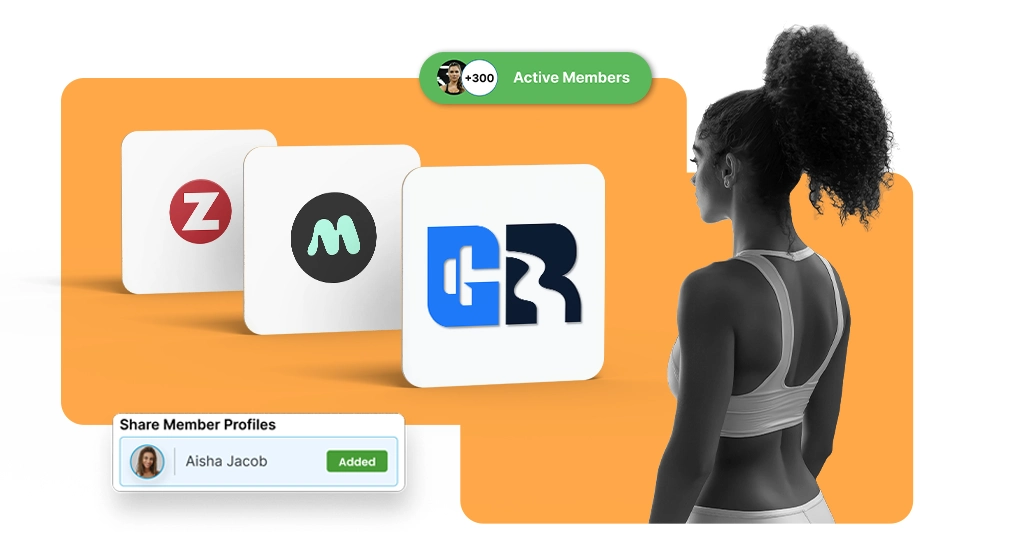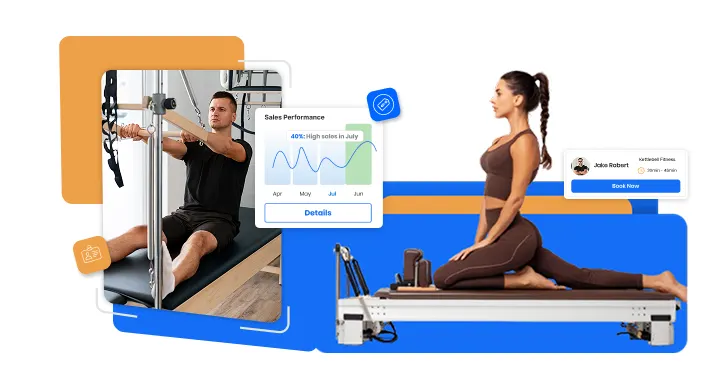Running a gym in 2026 is a very different game from what it was even five years ago. Back then, Membership software for gyms was something you bought to print bills, keep names in a spreadsheet, and perhaps send a reminder email when someone’s membership was up. Today, things are sharper. Competition is fierce, customers expect slick digital experiences, and the rise of hybrid fitness models means that member management isn’t just about who walks through your doors; it’s also about who logs in to your online classes, who books a PT session from their phone, and who decides to cancel because your competitor offered a better deal with one tap.
This is where gym membership software becomes more than a convenience. It’s your front desk, your billing team, your marketing manager, and, in some cases, your sales director; all tucked neatly into a single platform. The best membership software for gyms doesn’t just keep order. It grows your business. And with so many options on the market, the question isn’t “should I get gym membership software?” It’s “which one deserves my money and trust in 2026?”
Here are the fifteen contenders that matter most, starting with the one we believe sets the standard.
Gym membership software comparison (2026)
| Software | Best For | Pricing (Approx.) | Pros | Cons |
| GymRoute | All-in-one growth + management | From $149/month | Marketing + management in one, scalable, easy to use | Newer player vs. long-established brands |
| Mindbody | Large studios & wellness chains | From $99/month | Wide adoption, strong scheduling, and integrations | Can be expensive, steep learning curve |
| Zen Planner | Martial arts & boutique gyms | From $99/month | Belt tracking, attendance, simple UI | Limited advanced marketing features |
| Glofox | Boutique fitness & franchises | Request a quote | Great mobile app, sleek design, strong branding | Reporting is not as detailed, costs scale fast |
| Wodify | CrossFit & performance gyms | Request a quote | WOD tracking, community features, leaderboards | Niche focus, less suited to general gyms |
| Virtuagym | Hybrid fitness (online + offline) | Request a quote | Nutrition + training plans, online coaching | Interface can be clunky, and add-ons can be costly |
| PushPress | Startups & budget-conscious gyms | Free plan + paid from $139 | Affordable, simple setup, open integrations | Limited marketing automation |
| TeamUp | Small group studios | From $99/month | Clean interface, easy member booking | Less suited for large gyms |
| WellnessLiving | Multi-service gyms & studios | Starts around $69/month | CRM, loyalty tools, and strong scheduling | Support response can be slow |
| ClubReady | Multi-location gyms & franchises | Starts at $79 per month | Enterprise features, scalable, deep reporting | Expensive, complex onboarding |
| RhinoFit | Budget gyms & martial arts | Starts at $149/month. | Very affordable, simple features | Outdated design, fewer integrations |
| Perfect Gym | Global gyms & franchises | From $129/month | International support, enterprise-level tools | High setup cost, complex interface |
| ABC Fitness | Big-box gyms & chains | Starting at $49.99 per month | Robust, industry standard, 40+ years in fitness tech | Overkill for small gyms |
| Exercise.com | PTs & training-focused gyms | Custom pricing | Training plans, custom app, online programs | Pricing opaque, not gym-first |
| GymMaster | 24/7 gyms & access control | From $89/month | Door access, POS, flexible setup | Interface less modern |
1. GymRoute: Best all-in-one gym management & marketing software
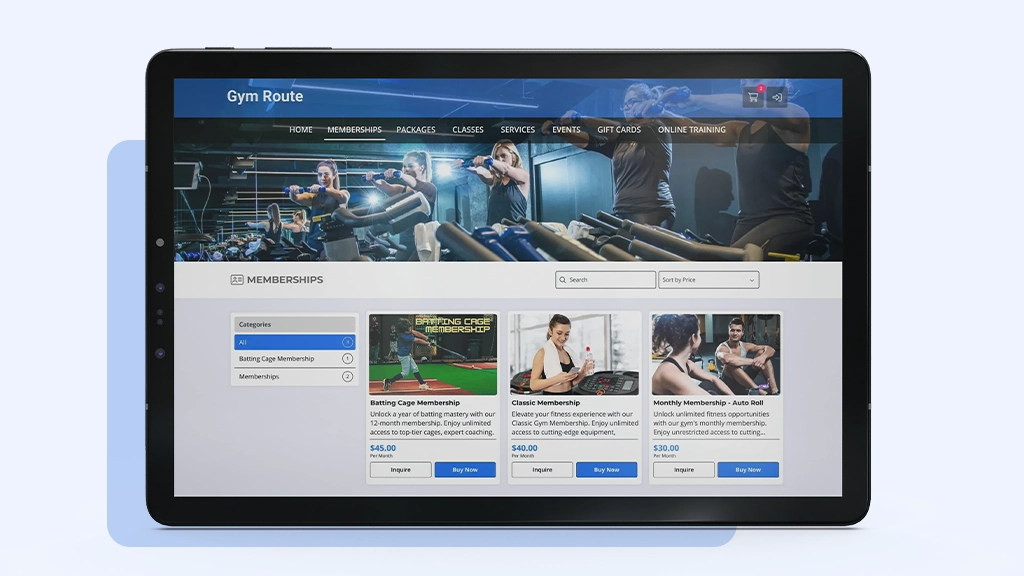
If you’re serious about running a gym that not only survives but thrives in 2026, GymRoute deserves to be top of your list. It isn’t just another membership system that lets people check in and pay bills. GymRoute has been built for growth. Its DNA is part administration, part marketing machine.
Where other platforms stop at managing bookings and payments, GymRoute goes further: it helps you generate leads, nurture them with automated email campaigns, and convert them into long-term members.
Imagine a platform that knows when someone signed up for a trial, tracks their engagement, and follows up with smart reminders to nudge them into full membership, all without you lifting a finger. That’s GymRoute.
It’s also versatile, whether you run a boutique studio with fifty members or a multi-location gym with thousands, GymRoute scales gracefully. Access control? Sorted. Member app with bookings and payments? Done. Reporting dashboards that actually make sense? Built-in.
Pricing: Flexible, based on gym size and features. Entry-level packages start competitively for small gyms, with scalable plans for franchises. Monthly pricing starts at $149.
Pros:
- Combines admin with serious marketing automation
- Intuitive, modern interface
- Scales from small gyms to multi-location brands
- Mobile app for both staff and members
Cons:
- Slight learning curve if you’re moving from very basic tools
- More advanced features best suit gyms with growth ambitions
Best for: Gym owners who don’t just want to keep their books in order, but want software that actively helps them grow.
2. Mindbody: Best for boutique fitness studios
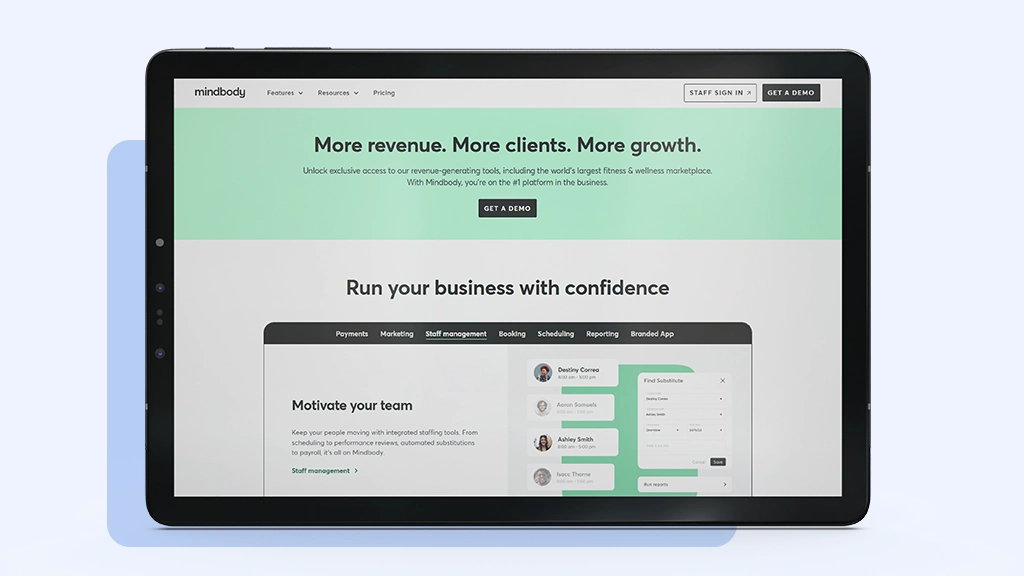
For many boutique studios, Mindbody has been the familiar name for years. If you run yoga classes, Pilates sessions, or boutique training programmes, there’s a good chance you’ve bumped into it.
Mindbody has carved its space by being more than a booking tool; it’s a lifestyle platform. Clients use the Mindbody custom mobile app to discover studios near them, book classes, and even pay on the spot. That means your gym doesn’t just get software, it gets plugged into an ecosystem of fitness enthusiasts who are already browsing.
The platform itself is polished, but it can be overwhelming. Features span class scheduling, staff management, customer engagement, and payment integration. It’s powerful, no question, but sometimes too powerful for smaller gyms that only want the basics. Still, for a studio that thrives on repeat classes and wants exposure through Mindbody’s marketplace, it’s a strong contender.
Pricing: Mindbody gym membership software cost starts at $99 per month for the basic plan, and you have to request a quote if you need to upgrade your plan to the enterprise level for additional features.
Pros:
- Access to the Mindbody consumer marketplace
- Robust scheduling tools
- Wide adoption and strong brand trust
Cons:
- Pricing can climb quickly
- Some users find the interface cluttered
- Support sometimes stretched thin
Best for: Boutique gyms and studios that want visibility in the wider Mindbody ecosystem and run class-based models.
3. Zen Planner: Best for martial arts & crossfit gyms
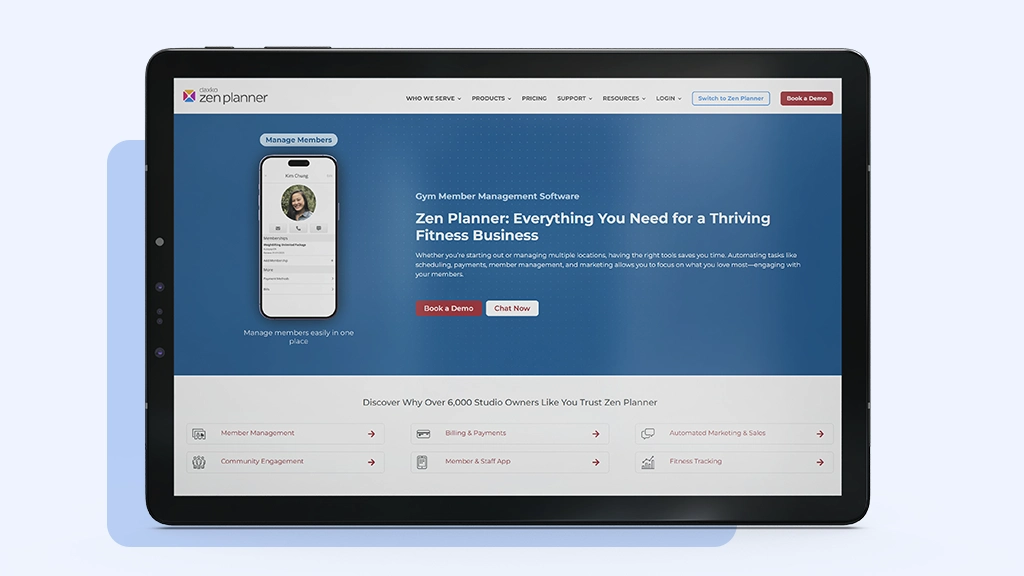
If you run a martial arts dojo, CrossFit box, or community-driven fitness club, Zen Planner may be your ideal partner. Its roots are in the high-engagement, high-retention fitness space, gyms where the bond between members and coaches is strong. That’s why Zen Planner goes deep on attendance tracking, belt and skill progression, and community engagement tools that standard gym software often overlooks.
The system covers all the fundamentals, billing, scheduling, and reporting, but what makes Zen Planner shine is how it captures the spirit of progress. Martial arts schools, for example, can track student ranks and communicate milestones seamlessly. CrossFit gyms can manage class caps, reservations, and even coach payroll from one dashboard.
On the flip side, it isn’t the most modern-looking interface. Some gym owners find it dated compared to newer players like GymRoute. But functionally, it delivers.
Pricing: Starts around $99/month, scaling by active members.
Pros:
- Tailored features for martial arts and CrossFit gyms
- Strong attendance and rank/skill tracking
- Integrated staff and payroll management
Cons:
- UI feels outdated
- Limited marketing automation compared to newer platforms
Best for: Martial arts schools, CrossFit boxes, and gyms with community-driven memberships that require more than just billing.
4. ABC Glofox: Best for growing gyms with ambition
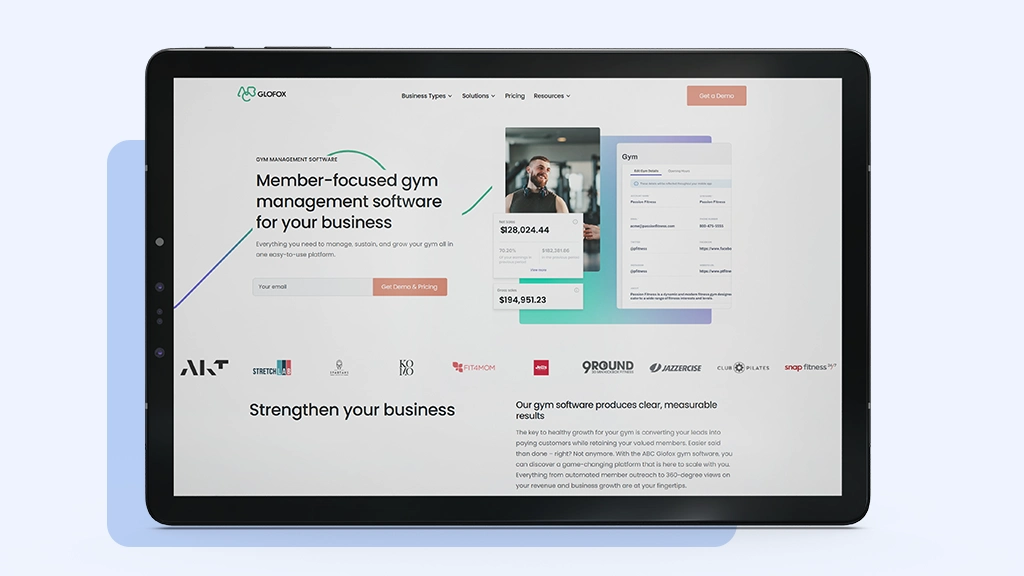
ABC Glofox has quickly made a name as a modern, sleek, and growth-focused gym membership software. Positioned as a challenger to legacy platforms, it combines all the core features (bookings, billing, check-ins) with tools aimed at helping gyms scale. Its standout feature is its branded mobile app; your gym can have its own app in the App Store or Google Play, giving members a digital touchpoint that feels like your brand, not generic software.
It also shines in multi-location support. Franchises and expanding studios appreciate the way Glofox centralizes management while still giving individual branches autonomy. Reporting dashboards are visual and accessible, making data less intimidating.
However, pricing isn’t always transparent, and smaller gyms sometimes find the branded app overkill. Still, for gyms with ambition, Glofox is a contender that keeps pace with modern member expectations.
Pricing: You have to request a quote to know about the pricing plan for ABC Glofox.
Pros:
- Branded mobile app experience
- Great for multi-location gyms
- Modern UI and reporting
Cons:
- Pricing is not fully transparent
- Some features are more useful to larger gyms
Best for: Ambitious gyms and franchises looking for modern tools and a strong branded digital presence.
5. Wodify: Best for crossfit and performance tracking
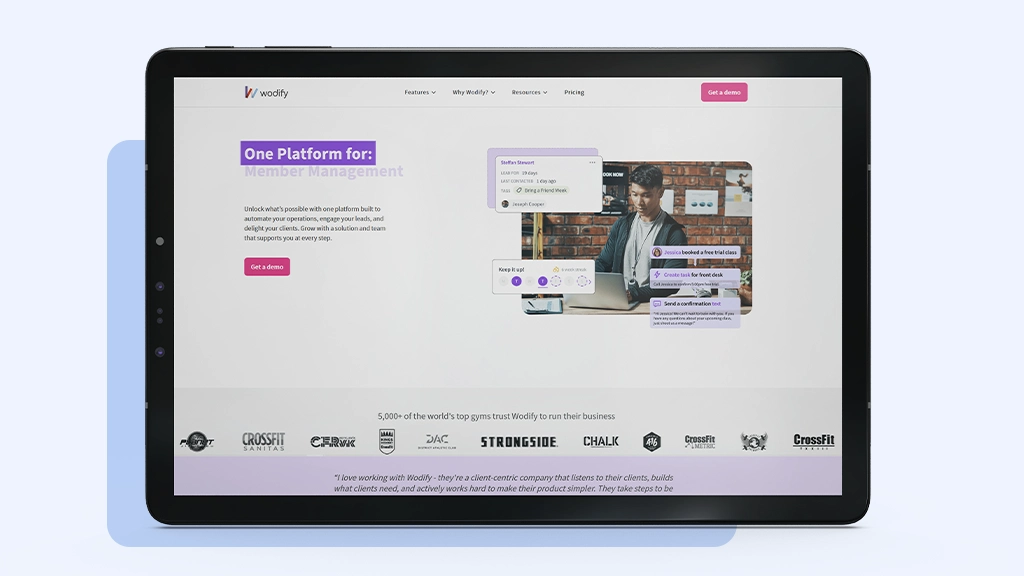
CrossFit gyms and performance-driven studios need more than a register and a payment system. They need a way to log workouts, track results, and keep athletes engaged. That’s exactly what Wodify delivers. Born out of the CrossFit boom, Wodify has positioned itself as the go-to for functional fitness spaces where performance data is as important as attendance.
Beyond billing and scheduling, Wodify shines in workout tracking. Members can log scores, monitor personal bests, and compete on digital leaderboards. This creates stickiness: when athletes see progress and feel part of a community, retention goes up. The system also offers class reservations, coach management, and reporting that digs into both business health and member performance.
The trade-off? It’s specialized. A general fitness club or traditional gym may find the workout features redundant, and some owners report that the billing tools are less intuitive than rivals. But for CrossFit and performance spaces, Wodify speaks the right language.
Pricing: You have to request a quote to know about the three different pricing plans that meet your business needs.
Pros:
- Advanced workout tracking and leaderboards
- Community engagement features are built in
- Solid for CrossFit and functional training
Cons:
- Less useful for general gyms
- The billing interface is not the smoothest
Best For: CrossFit boxes and performance-driven gyms that want to track more than attendance.
6. Virtuagym: Best for gyms offering hybrid fitness (in-person + online)
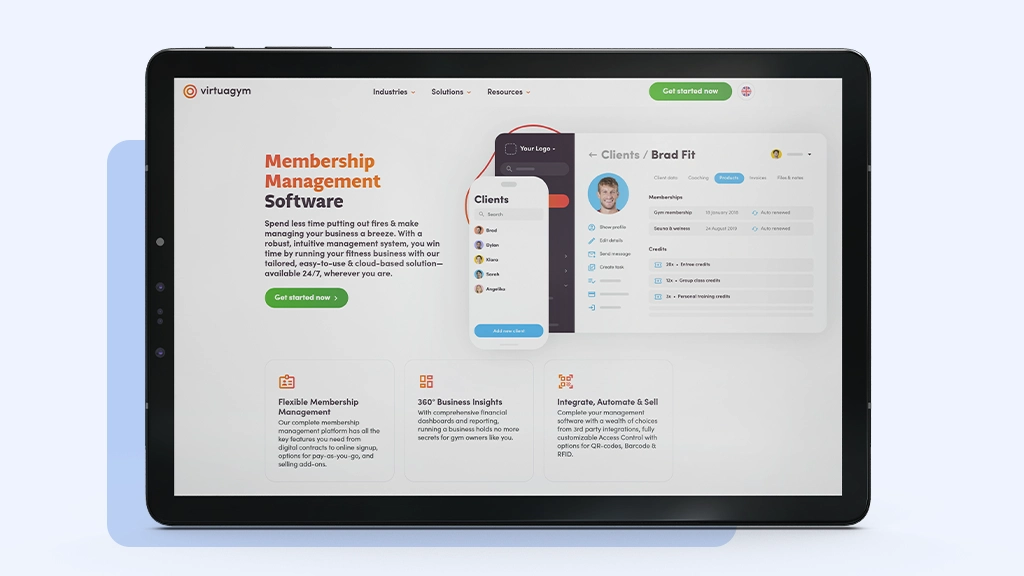
The fitness world isn’t confined to four walls anymore, and Virtuagym is built for exactly that reality. It blends traditional membership management with tools for online coaching, digital workouts, and nutrition tracking. For gyms looking to expand into hybrid fitness – part physical, part digital – Virtuagym offers a serious edge.
Members can access workout plans, track progress, and even receive nutrition advice through the mobile app. Coaches can assign plans remotely, creating revenue opportunities outside the gym floor. For owners, billing, scheduling, and reporting are all present, though not as deep as some specialist platforms.
It’s a jack-of-all-trades system, which is both its strength and weakness. If you’re a pure brick-and-mortar gym, you might not use the online coaching features. But if hybrid fitness is your future, Virtuagym is ahead of the curve.
Pricing: You have to request a quote to know about this gym billing software.
Pros:
- Strong hybrid/online fitness tools
- Nutrition and workout tracking built in
- Affordable entry point
Cons:
- Billing/reporting is less robust than others
- Some features are underdeveloped compared to specialists
Best for: Gyms or personal trainers expanding into hybrid models who want one system for in-person and online clients.
7. PushPress: Best for simplicity and automation

PushPress is one of those platforms that understands gym owners don’t have hours to waste learning gym membership software. It’s lightweight, intuitive, and automation-focused. Many gym owners switch to PushPress after being burned by clunky legacy systems.
The gym membership billing software offers the essentials: membership management, billing, scheduling, and check-ins. But what sets it apart is simplicity. Tasks are automated wherever possible, from billing runs to late payment follow-ups. Members get a smooth experience via mobile, while owners get clean reporting without being buried under dashboards.
PushPress also integrates well with tools like Mailchimp and Zapier, giving owners flexibility. It’s not packed with every feature under the sun, but that’s the point. For gyms that want lean, modern software without complexity, PushPress delivers.
Pricing: Free for a starter plan (with transaction fees), or $159/month for the Pro version.
Pros:
- Simple, clean, and automation-focused
- Free starter plan
- Integrates with popular apps
Cons:
- Not as feature-rich as bigger systems
- Limited marketing tools compared to GymRoute or Glofox
Best for: Small-to-medium gyms that value simplicity and automation without the bloat.
8. TeamUp: Best for class-based studios
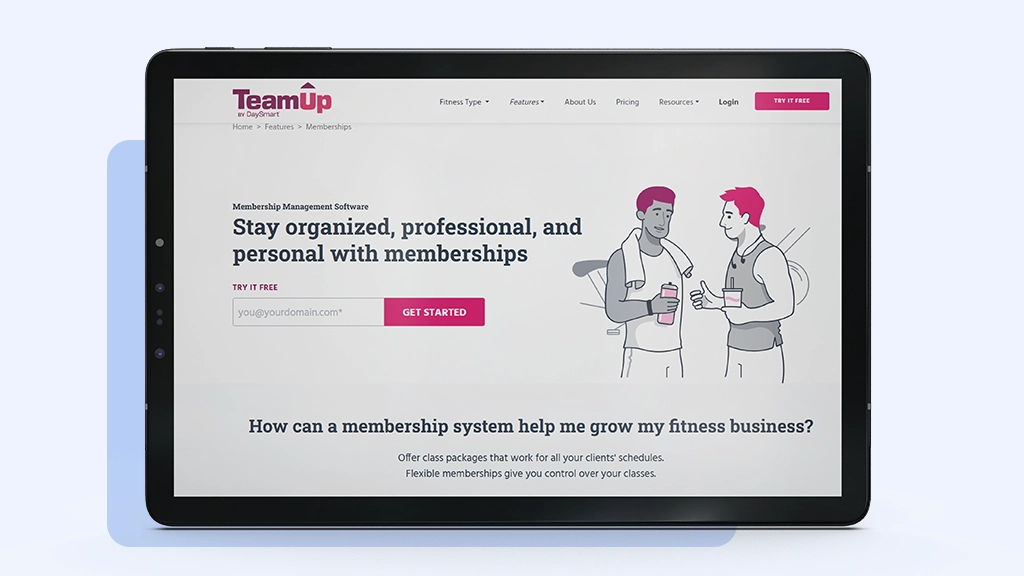
If your business revolves around classes, think yoga, pilates, spin, or martial arts, then TeamUp has carved out its niche precisely for you. Where some gym billing software overloads you with features you’ll never touch, TeamUp focuses on getting class management right. Bookings are easy, waitlists are automated, and cancellations are tracked neatly. That’s gold for studios where attendance fluctuates and every class spot matters.
The member-facing experience is smooth: clients book through a branded portal or app, pay seamlessly, and receive automatic reminders. On the admin side, recurring payments are painless, and you get reporting on attendance trends that help spot which classes are thriving (and which might need attention).
The trade-off? TeamUp isn’t the deepest when it comes to broader gym features like performance tracking or large-scale marketing. But if classes are your core product, TeamUp is less “software” and more “studio assistant.”
Pricing: Starts around $99/month, scaling with active members.
Pros:
- Excellent class booking and waitlist features
- Intuitive for both members and staff
- Focused, no-bloat platform
Cons:
- Limited beyond class-based gyms
- Fewer marketing tools compared to GymRoute
Best for: Yoga, pilates, spin, and martial arts studios where class booking is central.
9. WellnessLiving: Best for all-in-one wellness businesses
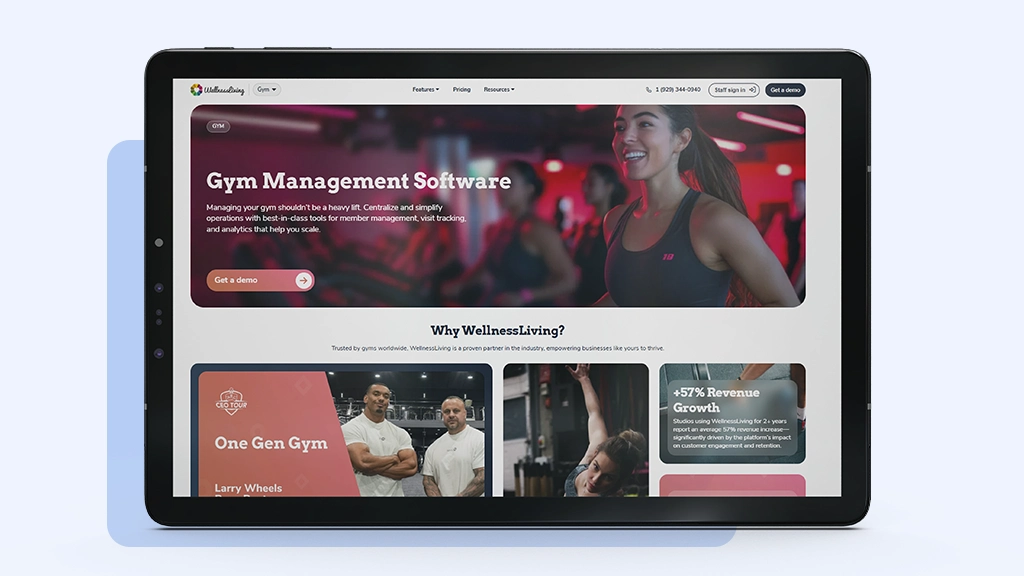
Some gyms are more than gyms. They offer yoga, massage, nutrition coaching, personal training, and maybe even spa treatments. For these hybrid businesses, WellnessLiving is a compelling all-in-one option. It covers the basics, memberships, scheduling, payments, and layers in client management, loyalty programs, and marketing automation.
What makes WellnessLiving attractive is how it handles multiple revenue streams. You can sell class packs, subscriptions, and individual appointments in one place. The loyalty and rewards features are also strong, giving members points for visits, referrals, or purchases, a clever way to boost retention.
The downside is that it can feel overwhelming. With so many tools in the box, owners sometimes report a steep learning curve. And for a pure gym setup, some of the wellness-focused features might sit unused.
Pricing: Starts around $69/month, with plans scaling up depending on features.
Pros:
- Great for gyms offering wellness add-ons
- Built-in loyalty and rewards programs
- Covers multiple revenue models
Cons:
- Feature-heavy and can be complex
- Less streamlined for pure gyms
Best for: Fitness businesses that combine training with wellness, spa, or nutrition services.
10. ClubReady: Best for franchise and multi-location gyms
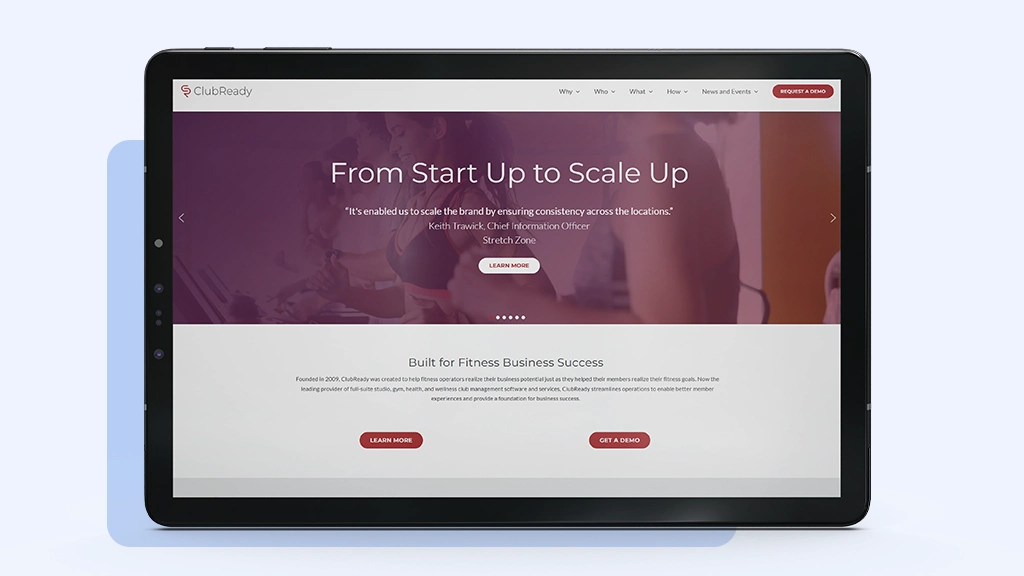
When you’re running more than one location, complexity multiplies. You need a gym management software that can centralize operations, standardize processes, and still give each site the flexibility it needs. That’s where ClubReady shines.
ClubReady is built with franchises in mind. It offers membership management, billing, scheduling, and reporting, but crucially adds tools for scaling: centralized dashboards, corporate oversight, and location-specific controls. For owners running two gyms, ten gyms, or fifty, this is the infrastructure that keeps the brand running smoothly.
Members get what they expect: easy check-ins, bookings, and payments. But owners get something harder to find: control across locations without drowning in admin. The trade-off is cost and complexity. Smaller gyms will find it overkill, but for franchises, it’s often worth the investment.
Pricing: Varies widely and starts at $79 per month. Often quoted directly.
Pros:
- Built for scaling across multiple sites
- Corporate dashboards and oversight tools
- Strong franchise support
Cons:
- Overkill for single-location gyms
- Higher cost compared to smaller systems
Best for: Franchises and multi-location gyms that need centralized control and oversight.
11. RhinoFit: Best budget-friendly choice
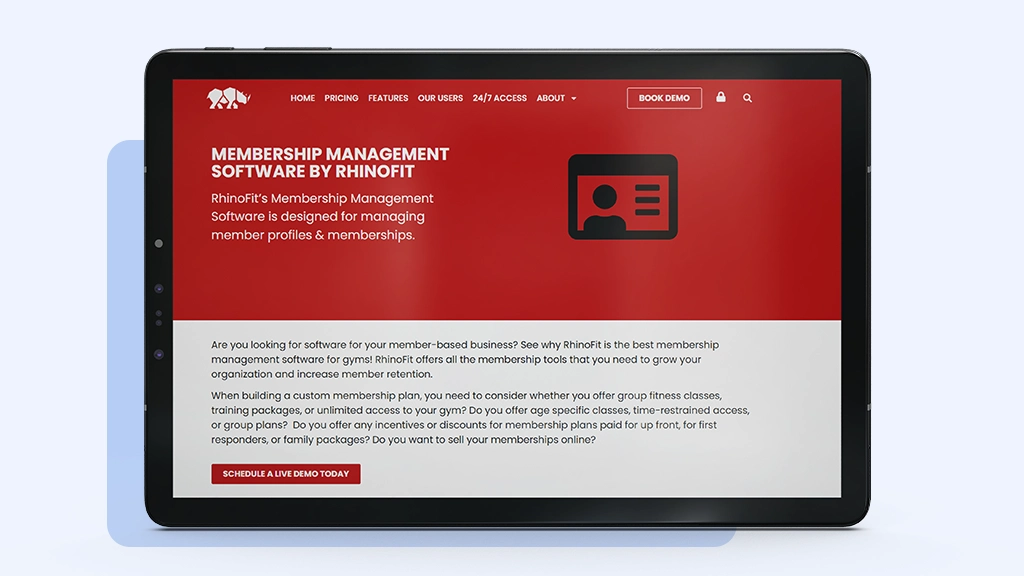
Not every gym can throw hundreds of dollars a month at gym membership software. For smaller or newer gyms, watching costs, RhinoFit is a budget-conscious option that still covers the essentials. It manages memberships, payments, class bookings, and reporting, without stacking on pricey add-ons.
Owners like RhinoFit’s straightforward setup and low cost. It’s cloud-based, mobile-friendly, and integrates with common payment processors. Members get self-service options for scheduling and payments, not fancy, but functional.
The limitations are shown in depth. Reporting is basic, marketing features are thin, and support isn’t as comprehensive as premium platforms. But if your priority is affordability and core functionality, RhinoFit is a solid entry point.
Pricing: Starts at $149/month.
Pros:
- Very affordable
- Covers core gym management needs
- Easy to set up and use
Cons:
- Limited advanced features
- Support and integrations are not as strong
Best for: Small gyms, bootcamps, or start-ups needing an affordable system that gets the basics right.
12. Perfect Gym: Best for mid-to-large facilities
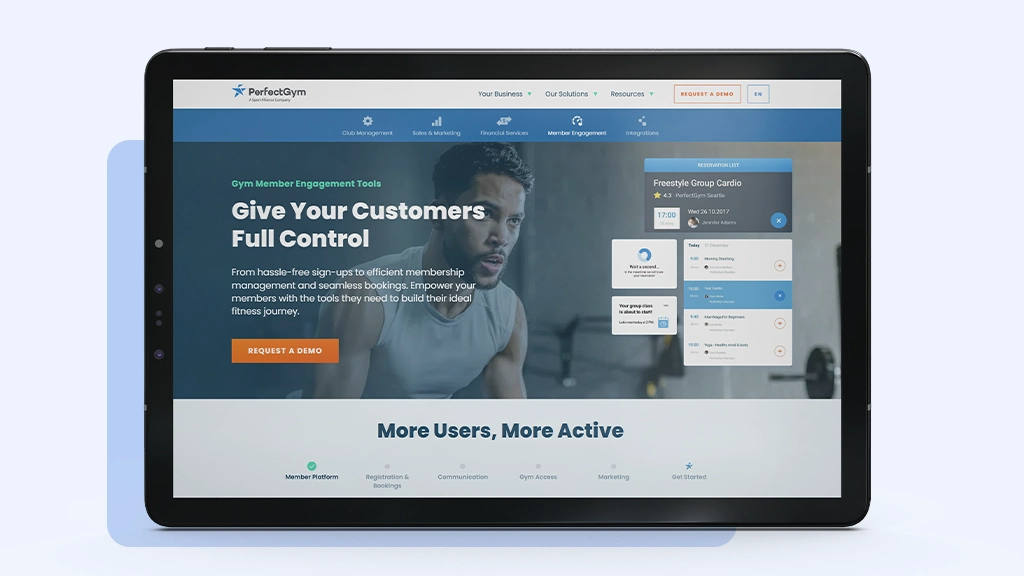
Perfect Gym lives up to its name for mid-to-large gyms that need more sophistication without going full enterprise. It offers robust membership management, billing, and scheduling, but layers in features like AI-driven reporting, marketing automation, and integrations with access control systems.
What makes Perfect Gym appealing is its scalability. You can start with core features and add more as your gym grows, from loyalty programs to custom-branded apps. Members enjoy a modern interface and frictionless booking, while owners get deep insights into revenue, attendance, and retention trends.
The trade-off is complexity and cost. It takes time to learn, and the price tag is higher than lightweight platforms. But for gyms looking to professionalize operations without jumping to franchise-level gym billing software, Perfect Gym is a compelling fit.
Pricing: The Starting price for Perfect Gym is around $129 per month.
Pros:
- Scalable features for growing gyms
- Strong reporting and analytics
- Customisable with add-ons
Cons:
- Learning curve for staff
- Higher pricing compared to smaller systems
Best for: Mid-to-large gyms wanting a modern, scalable platform with advanced insights.
13. ABC Fitness: Best for large-scale gyms and health clubs
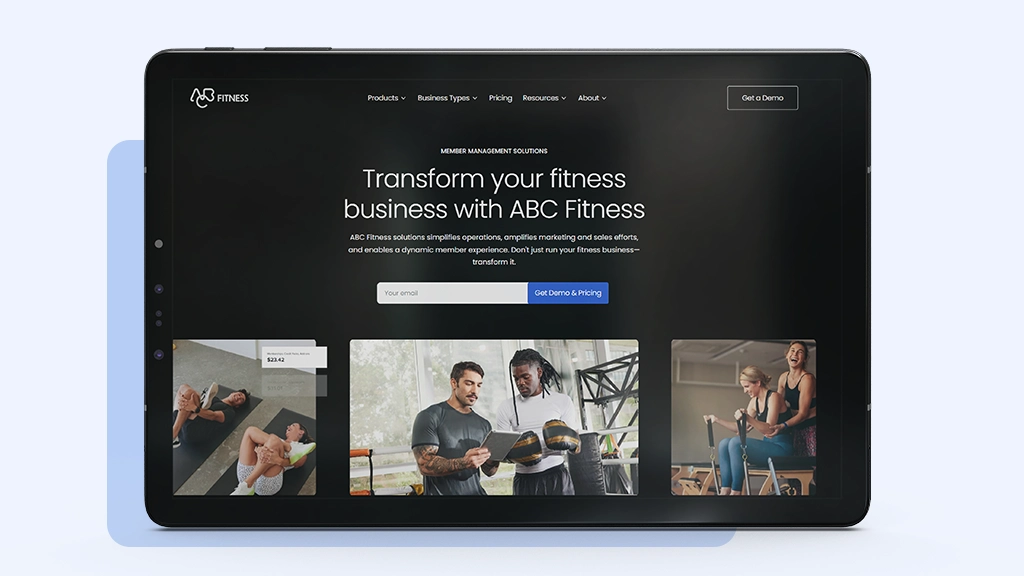
For decades, ABC Fitness has been a heavyweight in gym management software. Built for large-scale facilities and health clubs, it’s less about boutique polish and more about operational horsepower.
The system handles everything, memberships, billing, access control, and reporting, with the kind of robustness you need when managing thousands of members. Its reporting tools are deep, making it easier to manage retention, revenue, and staffing across larger facilities.
The downside is complexity. ABC Fitness isn’t lightweight or particularly intuitive for smaller gyms. It’s a membership software for gyms that assumes you have dedicated staff to run it. But for health clubs and large gyms, it’s battle-tested and highly reliable.
Pricing: The starting plan for ABC Fitness Solution starts at $49.99 per month.
Pros:
- Extremely robust for large gyms
- Excellent reporting and analytics
- Scales well with thousands of members
Cons:
- Too complex for small gyms
- Higher costs
Best for: Health clubs and large gyms managing high member volumes.
14. Exercise.com: Best for customisation and branded experience
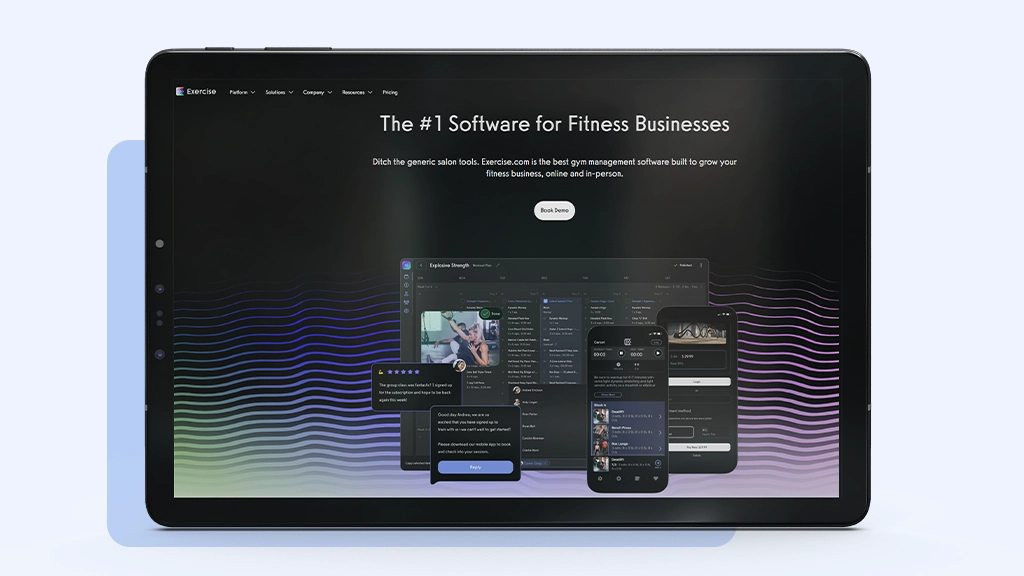
If you want a gym membership software that feels truly your own, Exercise.com is hard to beat. Unlike most gym billing software that comes with fixed templates, Exercise.com allows you to build fully custom-branded apps and portals. Your members don’t log into a third-party system. They log into your gym’s app.
Beyond branding, it covers the full suite: memberships, class bookings, workout programming, and payments. Personal trainers especially like its workout delivery and performance tracking features, which go beyond typical gym management systems.
The trade-off is cost. Exercise.com isn’t cheap, and the customization process can take time. But for gyms and studios that want to stand out with a tailored experience and deeper coaching tools, it’s a strong contender.
Pricing: Custom quote-based, generally higher-end.
Pros:
- Fully custom-branded app experience
- Strong workout and coaching tools
- Covers memberships, bookings, and payments
Cons:
- Higher cost than most platforms
- Setup/customisation can be time-consuming
Best for: Gyms, trainers, and studios that want a white-labelled, premium-branded digital experience.
15. GymMaster: Best for access control and 24/7 facilities
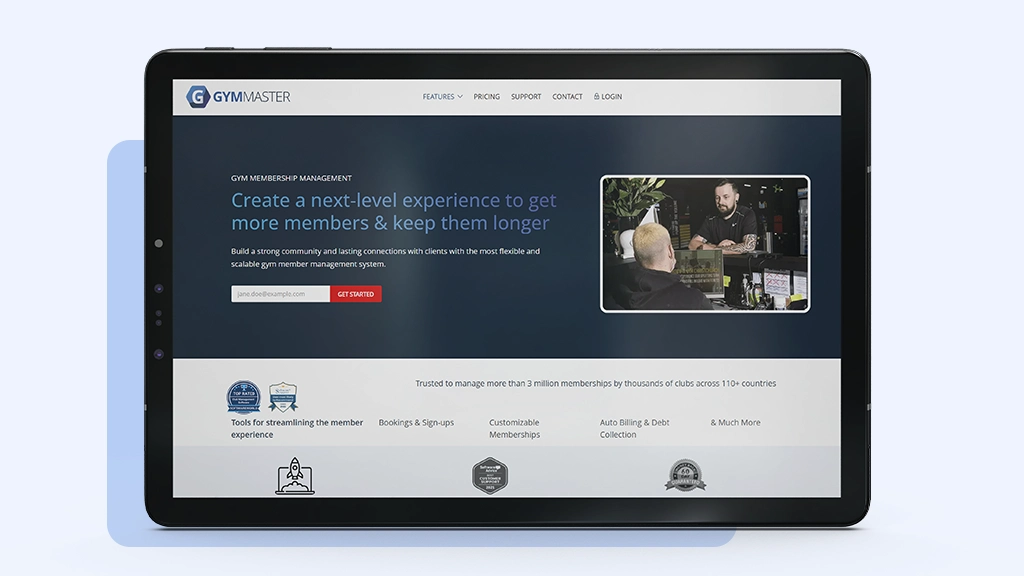
GymMaster has built a reputation as the go-to solution for gyms that run 24/7 or rely heavily on access control. The best gym membership software integrates seamlessly with key fobs, swipe cards, and biometric systems, making it easy to manage member access while automating check-ins.
Beyond access control, GymMaster also handles memberships, billing, point-of-sale, and class scheduling. It’s particularly strong in giving owners flexibility; you can run it on-site or in the cloud, and it scales from small gyms to larger operations.
The main drawback is that its interface and user experience can feel dated compared to slicker platforms like GymRoute or Glofox. But for gyms where physical access and security are critical, GymMaster is tough to beat.
Pricing: From $89/month, with extra fees for access hardware.
Pros:
- Excellent access control features
- Works well for 24/7 gyms
- Flexible deployment options (cloud or on-premise)
Cons:
- Dated user experience
- Some advanced features are locked behind higher tiers
Best for: 24/7 gyms, fitness clubs, and facilities where access control is a top priority.
How to choose the right gym membership software
Choosing gym membership software is a bit like choosing your head coach; get it right, and everything flows; get it wrong, and you’ll spend more time firefighting than building your business. Here are the big factors to weigh up:
Gym size & budget: Boutique studio vs. multi-location franchise
A single-location studio doesn’t need the muscle of an enterprise system built for franchises. In fact, overpaying for features you’ll never use is a quick way to cut into profits. Smaller gyms often thrive with simpler, more affordable systems like TeamUp or PushPress. On the flip side, multi-location gyms and franchises demand consistency and scalability; tools like ClubReady or ABC Fitness are designed for that.
Features needed: Marketing, scheduling, billing, reporting, apps
Every gym needs the basics: class scheduling, billing, and reporting. But the real question is, what’s mission-critical for your model? Do you need strong marketing automation? A mobile app for members? In-depth financial reporting? List out your must-haves before you compare providers.
Scalability: Will it grow with your gym?
Your membership software should grow with you, not hold you back. If you’re planning to expand from one location to three, or add new services like PT packages or online classes, make sure the platform won’t force a painful switch later. GymRoute, for instance, was built with growth in mind.
Ease of use: Staff adoption, member experience
The best membership software for gyms is the one your staff actually uses. Clunky systems slow everyone down. Likewise, if members can’t book classes, update payments, or check schedules easily, they’ll lose patience. Always test the user experience from both sides before you commit.
Integration needs: POS, access control, wearables, CRM
No gym is an island. Chances are, you’ll need your gym software to play nicely with payment systems, door access, wearable integrations, or even your CRM. Double-check integration capabilities. It’s often the difference between smooth automation and endless manual work.
Conclusion
Running a gym is hard enough. Managing memberships, chasing payments, juggling schedules, and trying to keep members engaged shouldn’t add to the stress. That’s why the right gym membership software isn’t just a back-office tool. It’s the backbone of a smoother, more profitable business.
From simple platforms for small studios to enterprise systems for global franchises, the choice is wide. But if you’re looking for one solution that goes beyond management and actually helps you grow, there’s one name that stands out.
GymRoute.
It’s built for 2026 and beyond, combining rock-solid member management with the marketing automation tools you need to attract, engage, and retain members.
So here’s the question: do you want software that just runs your gym, or software that helps your gym thrive?
Book a free demo of GymRoute today. See how it can transform your fitness business.
